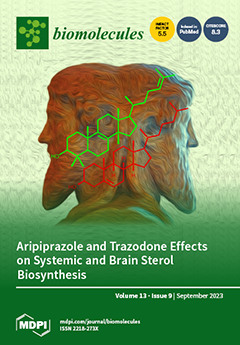Our study aimed to conduct a comprehensive biochemical profiling and metabolomics analysis to investigate the effects of arsenic-induced metabolic disorders, with a specific focus on disruptions in lipid metabolism, amino acid metabolism, and carbohydrate metabolism. Additionally, we sought to assess the therapeutic potential
[...] Read more.
Our study aimed to conduct a comprehensive biochemical profiling and metabolomics analysis to investigate the effects of arsenic-induced metabolic disorders, with a specific focus on disruptions in lipid metabolism, amino acid metabolism, and carbohydrate metabolism. Additionally, we sought to assess the therapeutic potential of resveratrol (RSV) as a remedy for arsenic-induced diabetes, using metformin (MF) as a standard drug for comparison. We measured the total arsenic content in mouse serum by employing inductively coupled plasma mass spectrometry (ICP-MS) after administering a 50-ppm solution of sodium arsenate (50 mg/L) in purified water. Our findings revealed a substantial increase in total arsenic content in the exposed group, with a mean value of 166.80 ± 8.52 ppb (
p < 0.05). Furthermore, we investigated the impact of arsenic exposure on various biomarkers using enzyme-linked immunosorbent assay (ELISA) methods. Arsenic exposed mice exhibited significant hyperglycemia (
p < 0.001) and elevated levels of homeostatic model assessment of insulin resistance (HOMA-IR), hemoglobin A1c (Hb1Ac), Inflammatory biomarkers as well as liver and kidney function biomarkers (
p < 0.05). Additionally, the levels of crucial enzymes linked to carbohydrate metabolism, including α-glucosidase, hexokinase, and glucose-6-phosphatase (G6PS), and oxidative stress biomarkers, such as levels of glutathione (GSH), glutathione reductase (GR), glutathione peroxidase (GPx), catalase, and superoxide dismutase (SOD), were significantly reduced in the arsenic-exposed group compared to the control group (
p < 0.05). However, the level of MDA was significantly increased. Molecular analysis of gene expression indicated significant upregulation of key enzymes involved in lipid metabolism, such as carnitine palmitoyl-transferase-I (CPT-I), carnitine palmitoyl-transferase-II (CPT-II), lecithin–cholesterol acyltransferase (LCAT), and others. Additionally, alterations in gene expression related to glucose transporter-2 (GLUT-2), glucose-6-phosphatase (G6PC), and glucokinase (GK), associated with carbohydrate metabolism, were observed. Amino acid analysis revealed significant decreases in nine amino acids in arsenic-exposed mice. Metabolomics analysis identified disruptions in lipid metabolomes, amino acids, and arsenic metabolites, highlighting their involvement in essential metabolic pathways. Histopathological observations revealed significant changes in liver architecture, hepatocyte degeneration, and increased Kupffer cells in the livers of arsenic-exposed mice. In conclusion, these findings enhance our comprehension of the impact of environmental toxins on metabolic health and offer potential avenues for remedies against such disruptions.
Full article






